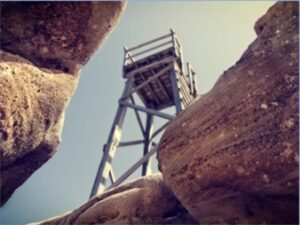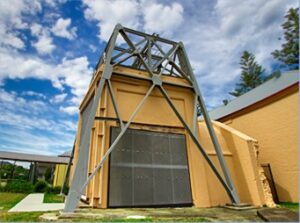Mining History
LAMBTON COLLIERY BUILDINGS. Ed Tonks
KITCHEN.
This space was the first upcast shaft (steam powered) winder house built in the period 1892-1893 when the colliery was developed as Durham Colliery. Even though the steam winder was replaced by an electrical winder in the mid 1930s, (housed in an adjoining annexe located to the immediate south and demolished in 1994) reportedly the steam winder remained until the early 1950s after which time the space was enlarged to include a lecture room, store and surveyor’s drawing office.
STORE MAIN WORKSHOP AREA.
This biggish space was the first boiler house for the Upcast Shaft. It also dates from the Durham Colliery era of 1892-1893. Steam was provided by two Lancashire boilers. In about 1910 a new boiler house was erected east of the original. In 1923 the first boiler house was marked as a store. The interior view provides a fine angle to view the distinctive and industrial-trend setting round –arched cast iron windows. Externally these windows complement the brick panels, plinths and ventilated friezes. This design was selected by Thomas Croudace as the best from British Colliery design of the late 19th century. Where else can this architecture be seen in Australia? Interestingly when BHP developed John Darling Colliery in the 1920s the buildings incorporated this style of window.
UPCAST SHAFT BUILDING and HEADFRAME.
This shaft is the reason for the other buildings. It is an industrial and engineering gem.
This group consists of a shaft, headframe, access chamber, fan housing and engine room for the fan. Work on the sinking of this shaft commenced in 1888 and finished in 1890. Because of the sand and generally soft material encountered in the early sinking efforts Tubbing was used to a depth of about 21 metres (70 feet) until solid rock was encountered. Depth of shaft is about 133 metres. Tubbing consists of flanged, stiffened and bolted plates of curved cast iron. This shaft is probably the only point in Australia where this ingenious 19th engineering application can be seen.
Initially a timber headframe was constructed above this shaft as a means of entry and egress. The metal one probably dates from the mid 1930s following acquisition of the colliery by BHP. The timber bases of the 1890s headframe can still be seen.
By January 1893 a 13 metre (42 feet) diameter Waddle fan, the largest in the Newcastle Coalfield had been installed at Durham Colliery. Such a large fan was installed partly in response to two methane gas ignitions and explosions. The flanges and attachment points for the Waddle fan can still be seen. Over time no less than four different fans have operated in conjunction with the upcast shaft.
The large building to the south of the upcast shaft is the independent engine house powering the Waddle fan. It apparently operated until the Scottish Australian Mining Company closed the colliery in 1928. Following BHP ownership electrical power was supplied from John Darling Colliery at Belmont North and the fan engine house became an electrical switch room.
LAMBTON COLLIERY, REDHEAD
Heritage Profile (Ed Tonks)
- These buildings and structures were associated with Lambton Colliery’s upcast shaft.
- The upcast shaft used a fan to ventilate the underground workings – this shaft was also used as a second means of entry and exit from the mine.
- This site has a European industrial history dating back to at least 1886.
- These brick buildings were constructed in the early 1890s to a design prepared by Thomas Croudace, colliery manager of the Scottish Australian Mining Company.
- Croudace’s design reflected what was then the “best of English colliery practice” – he planned the company’s new mine as a ‘model colliery”.
- The Waddle fan originally associated with these buildings had a 42 feet diameter; in its time it was the largest of its type on the Newcastle Coalfield.
- Throughout its planning and operational life the colliery was associated with at least twelve fatalities.
- Over time the colliery has been referred to by a variety of names – these include Ryhope, Durham, Lambton No. 2, Lambton Colliery B Pit and Lambton.
- The colliery has been operated by different companies throughout its history. These companies are the Scottish Australian Mining Co; BHP Co. Ltd, Pacific Copper, a subsidiary co. of the Bond Corporation, and FAI Mining Ltd.
- Under BHP’s ownership Lambton Colliery became the first fully mechanised colliery in Australia.
- During 1971 Lambton Colliery employed 335 people.
- During its life Lambton Colliery worked three seams – Borehole, Victoria Tunnel, and Borehole.
- Depending on the seam worked Lambton Colliery worked west towards Bennetts Green and Windale, south towards Belmont and east beneath the South Pacific Ocean.
- Prominent names associated with Lambton Colliery include Thomas Croudace, Frank Croudace, Sydney Croudace, W. Short, Bennett Williams, JCL Rae, Peter Brownlie, Ivan Balks and George Mowbray.
- Lambton Colliery’s production was railed over the Adamstown to Redhead, later extended to Belmont, Railway to the port of Newcastle and from 1932 to the Newcastle Steelworks. This railway that once served Lambton Colliery has been developed as the Fernleigh Track.
- This group of Lambton Colliery buildings is the last 19th Century Colliery group of buildings that survive in NSW . Lambton’s downcast group of buildings was demolished in 1993 following consent of the Land and Environment Court.
Further reading
Conservation Study of Lambton Colliery. Irving & Pratten. 1992.
Also LMCC prepared a tan, light brown covered booklet.
Doring C & MJ “Statement of Evidence of Carl Doring and Margaret Doring in the Matter of the City of Lake Macquarie –v- FAI Mining Ltd in the NSW Land and Environment Court” December, 1992.
Tonks, Ed “Adamstown via Fernleigh – Trains and Collieries of the Belmont Line” NSW RTM 1988.
Tonks, Ed “Lambton by the Sea – The last 19th Century Colliery on the Newcastle Coalfield” Headframe Publishing 1995.

